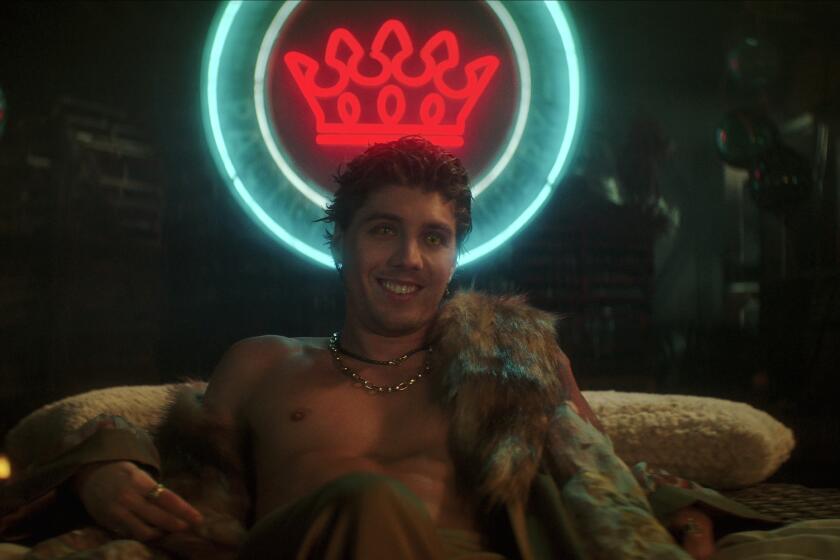‘Real World’ keeps turning, and keeps viewers tuning in
The premise was simple: Put a bunch of twentysomethings in a cool pad and watch their lives unfold on camera. And yet the seemingly basic (and cheap) idea behind “The Real World” helped birth a genre that has eaten television whole.
A show that started as a novelty item in a land of scripted fare has launched more than just a sub-genre. Reality programming has become part of the fabric of our society, turning numerous D-list celebrities (Paris Hilton, Kim Kardashian, the late Anna Nicole Smith) into real stars. The TV grid now is flooded with reality shows, some of which (“Survivor,” “The Amazing Race”) have run for a decade.
Keeping a relatively low profile through it all has been MTV’s pioneering experiment. Now “The Real World” is premiering its 25th — that’s right, 25th — season, set in Las Vegas, on Wednesday.
“‘The Real World’ has a place in history,” said Jonathan Murray, who created the show with the late Mary-Ellis Bunim, on a recent afternoon at his office in Van Nuys. “It dared to prove that real people can sometimes be more compelling than what a writer can dream up.”
Long before the tanned cast of “Jersey Shore” was fist-pumping its way across MTV (and America’s consciousness), a revolving cast of roommates was laying down the blueprint for how to wring entertainment out of everyday interactions among young people coming of age.
In its early years, “The Real World” aimed to capture intensely personal dramas while also bringing to the forefront social issues like race, AIDS, abortion and addiction.
But those earnest intentions seemed to fade away during the show’s first stay in Las Vegas in 2002, when Southern belle Trishelle Cannatella reached across a hot tub and began kissing party girl roommate Brynn Smith. Steven Hill, the straight guy who put himself through school by manning a gay bar, naturally joined in.
“We changed ‘The Real World,’” said Cannatella, whose drunken antics and pregnancy scare tabloidized the series. “It was something relevant. Now it’s mostly hot tubs, sex and drinking.”
Although the producers briefly attempted to go back to the show’s more issue-oriented roots with the Brooklyn 2008 season, the “Real World: Las Vegas” cast seems to follow more in the footsteps of the libidinous original Vegas season.
“We’re no angels,” said Dustin Zito, 24, who has a bipolar, drug-addicted mom, an abusive stepdad, and used to appear in gay porn. “But you know, we each have a story to share too. We’ve all been through a lot. And we’re on a show that gives us a platform to share our stories.”
Even as MTV expands its portfolio of scripted series such as “Skins” and “The Hard Times of R.J. Berger,” its reality offerings continue to be much more powerful, both in terms of ratings and effect on pop culture. The teens of “16 and Pregnant” — and its spinoff “Teen Mom” — are tabloid covergirls. And “Jersey Shore” brings in numbers that compete with those of broadcast networks.
MTV Executive Vice President of Programming Chris Linn is quick to credit the network’s pioneer in the format, noting that “[‘Jersey Shore’] wouldn’t be here if it weren’t for ‘The Real World.’ There’s no denying that.”
But MTV didn’t set out to create reality TV. The network originally wanted an old-fashioned scripted drama about young people, made with paid writers and young, hot actors — something like “Skins.” The network hired Murray, a veteran news and documentary producer, and Bunim, a soap opera producer who had worked on “As the World Turns” and “Santa Barbara,” to develop a series. (Bunim died in 2004 from breast cancer.)
The result was a drama called “St. Mark’s Place.” But estimated costs for the series came in at “whopping” $500,000 per episode, Murray said, and the show was dropped while in development.
So the duo came up with a cheaper, vérité alternative that came to be known as “The Real World.”
“MTV jumped on it,” Murray recalled, pointing out that the leaner $100,000-per-episode cost made it “a sure thing.”
“Real World: New York” premiered in February 1992 and featured seven young strangers living in a posh loft in SoHo, with cameras following their every move. It was a format that took some adjustment for MTV viewers schooled on music videos.
“I was in college and I was flipping channels one day and caught it,” said Judd Winick, 41, who appeared in the San Francisco-set third season. “I thought, ‘What the hell is this?’ Is this a soap opera? No … it’s not; these are actual people. Wait, is this a documentary?”
The first season had close to 1 million viewers per episode. A franchise was born.
The series would eventually dot the country — from San Francisco and Miami to Philadelphia and New Orleans — and the globe, with seasons in London, Paris and Sydney, Australia, over nearly two decades.
As the MTV audience’s taste shifts — in recent years, the desire was for fantasy fulfillment (“What if I was rich?”) with shows such as “My Super Sweet 16” and “The Hills,” then for grittier people in the vein of the “Jersey Shore” cast — “The Real World” has remained a constant presence.
“It kind of got drowned in the mix” of increasingly flashy reality shows, according to Mark Andrejevic, an associate professor of communication studies at the University of Iowa. “But everyone knows about it in some way. It’s become a classic TV series much in the way of ‘The Cosby Show’ or ‘I Love Lucy.’”
“It’s almost a rite of passage for our audience,” Linn said. “If it wasn’t doing well for us, it wouldn’t be celebrating its 25th season.”
Its most recent season, which revisited New Orleans, averaged 1.8 million viewers.
And there’s no end in sight. And maybe that’s just as well because, as Cannatella said, “There will always be seven young strangers who want to live in a cool house if MTV is willing to foot the bill.”
‘The Real World’
Where: MTV
When: 10 p.m. Wednesday
Rating: TV-14 (may be unsuitable for children under the age of 14)
The complete guide to home viewing
Get Screen Gab for everything about the TV shows and streaming movies everyone’s talking about.
You may occasionally receive promotional content from the Los Angeles Times.



